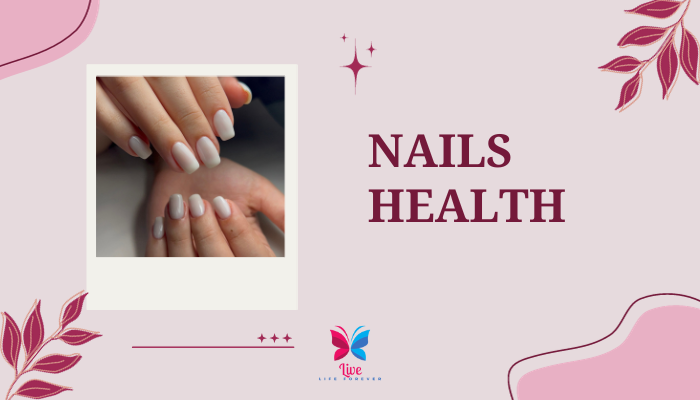Decoding Your Nails Health: Unveiling the Clues Hidden in Your Health

Decoding Your Nails Health: Unveiling the Clues Hidden in Your Health

Nails Health
Your nails can be an indicator of your overall health and may change in response to illness or nutrient deficiencies. Abnormalities in nail color, texture, or shape can signify various medical conditions. Read on to learn what your nails might be trying to tell you about your health.
Introduction
The nails are made up of keratin, the same protein that makes up the hair and the outer layer of skin [1]. The growth and regeneration of nails stems from the nail matrix, the area under the cuticle at the nail’s origin [2]. As new cells are produced by the matrix, the old nail cells are pushed forward until they eventually shed off at the end of the nail.
Fingernails typically grow about 0.1 mm per day, while toenails grow more slowly at about 0.05 mm per day [3]. It takes around 6 months for fingernails and 12-18 months for toenails to fully regrow.
The appearance of the nails can signify changes inside the body. Medical professionals may examine patients’ nails for abnormalities as clues about their health. Let’s explore what your nails might be indicating about the state of your health.
Nail Abnormalities and What They Mean
Discolored Nails
Nail color varies naturally based on melanin pigmentation in the nail bed. However, unusual discolorations can indicate health issues:
- White spots or streaks (leukonychia) – These white marks are common. They may appear after injury and grow out over time. But they can signal low zinc or iron deficiency anemia [4].
- Yellow nails – Thick, slow-growing yellow nails may indicate lung disease, thyroid disorders, diabetes or psoriasis [5]. Yellowing under the nail can be a sign of fungal infection.
- Blue nails (cyanosis) – Bluish discoloration occurs when blood oxygen levels are low. This may indicate lung problems or heart conditions [6].
- Black streaks or nail bed – A black color may be caused by melanoma skin cancer or a benign condition called nail melanocytic activation [7]. See a doctor promptly about any unusual black lines.
- Red skin around nails (paronychia) – Swelling and redness around the nails can indicate infection or chapped skin. This may occur more often for nail biters or finger/thumb suckers [8].
Unusual Nail Texture or Shape
In addition to color changes, the texture and shape of nails can also indicate health issues including:
- Pitting or small dents – Nail pitting occurs commonly with psoriasis. It can also indicate reactive arthritis, alopecia areata or connective tissue disorder [9].
- Crumbling nails – Very dry, fragile nails that split or crumble easily may mean thyroid disease, kidney failure or problems with circulation [10].
- Clubbed nails – Nails with soft, rounded tips may indicate lung conditions, cardiovascular disease, liver abnormalities or inflammatory bowel disease. Keeping nails trimmed can minimize any discomfort [11].
- Spoon-shaped nails (koilonychias) – Concave, spoon-shaped nails can signify iron deficiency anemia, hemochromatosis or hypothyroidism. If caused by anemia, the concavity typically disappears once iron levels return to normal [12].
- Grooves or ridging– Vertical ridges tend to become more prominent with age as the nails grow more slowly. But newly developed deep grooves or ridges may warrant investigation into arthritis, psoriasis or nutrient deficiency [13].
When to See a Doctor about Nail Changes
Occasionally nails can develop harmless abnormalities. But any sudden changes in nail color, shape, thickness or texture should be evaluated, especially when other symptoms are also present.
See a doctor promptly if you notice any of the following [14]:
- Discoloration accompanied by pain, swelling or discharge – This may indicate infection or melanoma.
- Splinter hemorrhages (tiny dark spots that look like splinters) – These warrant colon cancer screening.
- One nail with changes while the others look normal – This could signify skin cancer.
- Nail separation from the nail bed – This can lead to infection.
- Yellow nail discoloration with respiratory symptoms – This may indicate lung disease.
Let your doctor know about any medications you take, exposure to chemicals, smoking status, history of infection, family history and other medical conditions [15]. Diagnostic tests may include a physical exam, blood tests, imaging scans or nail biopsies. Underlying disorders can then be pinpointed and treated.
Dietary Minerals for Healthy Nails
In many cases, nutritional deficiencies lead to nail abnormalities that improve with treatment. Be sure to get adequate key minerals for optimal nail health [16]:
- Iron – Boosts blood oxygen. Needed for normal pink nail beds.
- Zinc – Supports protein synthesis for fast nail growth.
- Calcium – Strengthens nails and prevents brittleness.
It’s also important to get sufficient vitamins D, B12 and other essential nutrients [17]. A balanced diet or quality supplements can help prevent mineral shortfalls to keep your nails looking their best.
The Takeaway: What Fingernails Reveal
The nails provide a snapshot of health from head to toe. In many cases, abnormalities reflect illness elsewhere in the body. Nutrient deficiencies can also cause changes in nails.
Carefully examine your fingernails and toenails regularly. Note any unusual discoloration, thickening, excessive dryness or separations. Also watch for distorted shapes, grooves or newly developed white spots.
Schedule an appointment promptly if your nails signal potential health issues. Early diagnosis and treatment of underlying medical conditions can help restore strength and beauty to your nails. With proper nutrition and disorders managed, you can display nails that reflect vibrant wellness.

Frequently Asked Questions
What do black lines on nails mean?
Black streaks or other nail discoloration should be evaluated by a doctor. Black lines may be caused by nail melanoma (melanocytic activation), skin cancer (melanoma), nail trauma, infections or medications [18]. Diagnostic tests can determine if there is an underlying medical issue that needs treatment.
What vitamin deficiency causes nails peeling?
Brittle, peeling nails that easily crack or split can be caused by certain vitamin deficiencies [19]. In particular, inadequate biotin as well as vitamins A, C and some B vitamins can contribute to weakened nails that peel. These vitamins support keratin formation and collagen proteins that make up the nail structure [20].
What disease causes spoon shaped nails?
Spoon-shaped nails with a concave appearance have been linked to iron deficiency anemia, hemochromatosis and hypothyroidism [21]. Low iron levels affect hemoglobin proteins that deliver oxygen with the bloodstream. With inadequate oxygen circulation, changes can occur in nail growth and regeneration. Treating the underlying condition can help restore normal nail shape.
Can nails indicate liver problems?
Yes, the nails may show changes reflecting liver disease or damage [22]. New nail abnormalities combined with yellow skin or eyes (jaundice) may indicate hepatitis, cirrhosis, liver cancer or impaired liver function. Nail clubbing with rounded fingertips can also occur with chronic liver disease. See a doctor promptly about abnormal nails with other liver-related symptoms.
When should you be concerned about white lines on nails?
Occasional white lines or flecks on the nails are usually nothing to worry about. But newly developed pronounced white lines across multiple nails warrant medical evaluation, especially when other symptoms are present [23]. These may be whole nail leukonychia or partial leukonychia bands. Sudden onset in adults can signal nail trauma, toxicity, infections or autoimmune disorders.
Can fingernails detect lung cancer?
Yes, nails sometimes show changes that provide clues pointing to lung cancer. Thickened yellow nails can indicate respiratory conditions [5]. And nail clubbing with rounded nail beds occurs more often in people with lung cancer compared other cancers [24]. Lung tumor cells produce protein signals impacting nail matrix cells. If you notice odd nail changes, ask your doctor whether diagnostic testing is recommended.
Can nails reflect heart health?
Yes, nails can sometimes provide hints about cardiovascular health. Bluish nail beds (cyanosis) occur when blood is not oxygenated properly, potentially due to heart defects or lung diseases [6]. Pale nail beds may indicate anemia, which diminishes oxygen supply. Spoon-shaped nails can signify iron deficiency anemia [12]. And nail clubbing can happen with pulmonary hypertension or cyanotic heart disease [11]. Any unusual nail changes warrant an evaluation of heart health.
Are ridges on nails normal or abnormal?
It is common for fingernails and toenails to develop vertical ridges as people age [13]. The nails simply grow more slowly, causing minor grooves. But newly developed deep or numerous ridges can signal thyroid disorders, diabetes, psoriasis, reactive arthritis or nutrient deficiencies. Ridges combined with nail pitting or crumbling also justify medical evaluation to check for underlying disease.
What hormones influence nail growth?
Estrogen, progesterone, testosterone and thyroid hormones impact the rate of nail growth [25]. That’s why many women experience changes during puberty, pregnancy and menopause when these hormone levels shift dramatically. Biotin, vitamins D and B12 also support nail regeneration [17]. Make sure diet and supplements provide adequate nutrients to balance hormone activity.
How soon do nails grow back after injury?
Damaged nails will fully grow back over several months [3]. Fingernails grow about 0.1 mm daily, replacing themselves every 6 months on average. Toenails grow back even more slowly. So have patience! Applying moisturizer and vitamins can nourish nails for optimal regrowth after trauma. Avoid picking or tearing nails while they mend. If a nail falls off from injury, a new one will reform as matrix cells regenerate.
Conclusion Of Nails Health
Your fingernails provide insight about your internal health on display at your fingertips. Examine nails regularly for any abnormal changes. Undesirable variations in color, thickness, texture or shape may warrant investigation. Detecting and treating hidden disorders early leads to better outcomes. With healthy circulation and nutrients from good diet and lifestyle practices, nails can signal strong overall well-being.





Simply desire to say your article is as surprising The clearness in your post is simply excellent and i could assume you are an expert on this subject Fine with your permission let me to grab your feed to keep up to date with forthcoming post Thanks a million and please carry on the gratifying work
Fantastic beat I would like to apprentice while you amend your web site how could i subscribe for a blog site The account helped me a acceptable deal I had been a little bit acquainted of this your broadcast offered bright clear concept
really thnakful for the appreciation..but am sorry i havent started the subscrption yet , i will surely let u know in future
Usually I do not read article on blogs however I would like to say that this writeup very compelled me to take a look at and do so Your writing taste has been amazed me Thanks quite nice post